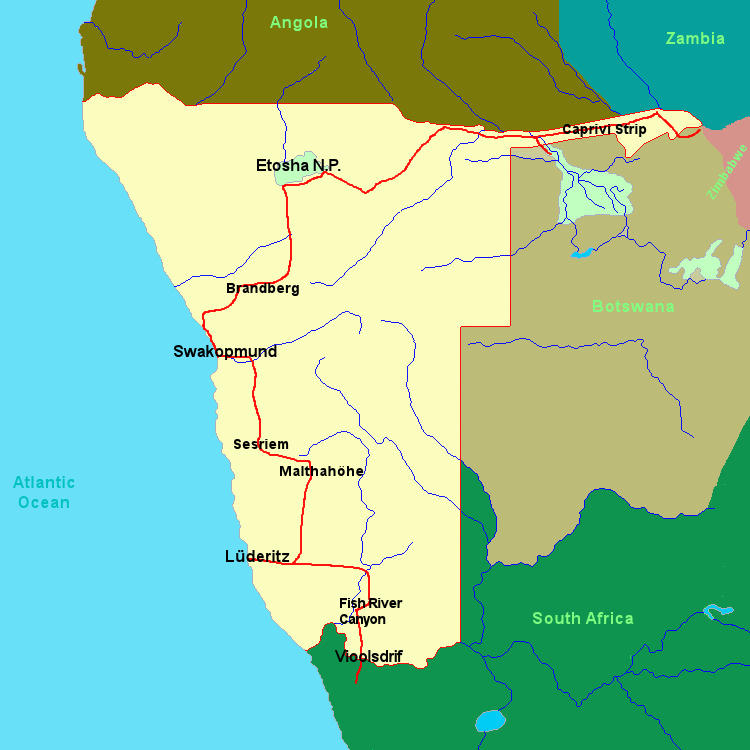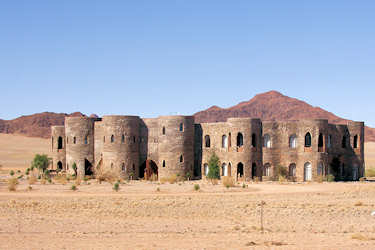Namibia

Historie
Until about 2.000 years ago the original hunters and gatherers of the San people were the only
inhabitants in Namibia. The San (also called Bushmen) were hunters and gatherers with a nomadic lifestyle. The
most important part of their diet consisted of fruits, nuts and roots, but they also hunted different kinds of
antelopes. At this time the Namaqua (also known as Hottentots) settled around the Orange River in the
south on the border between Namibia and South Africa where they kept herds of sheep and goats.
Both the San and the Namaqua were Khoisan Peoples, and spoke languages from the Khoisan language group.
In the 9th century Damara, another Khoisan group, entered Namibia. It is unclear where they came from, but they
settled in the grasslands in central Namibia, known as Damaraland.
During the 17th century the Herero, pastoral nomadic people keeping cattle, moved into Namibia. They came from
the east African lakes and entered Namibia from the northwest. First they resided in Kaokoland, but in the middle
of the 19th century some tribes moved further south and into Damaraland. A number of tribes remained in Kaokoland:
these were the Himba people, who are still there today.
In the 19th century white farmers, mostly Boers moved farther northwards pushing the indigenous Khoisan peoples,
who put up a fierce resistance, across the Orange River. Known as Oorlams, these Khoisan adopted Boer customs
and spoke a language similar to Afrikaans. Armed with guns, the Oorlams caused instability as more and more came to
settle in Namaqualand and eventually conflict arose between them and the Nama. Under the leadership of Jonker
Afrikaner, the Oorlams used their superior weapons to take control of the best grazing land.
The last group to arrive in Namibia before the Europeans were the Basters – descendants of Boer men and
African women (mostly Nama). Being Calvinist and Afrikaans-speaking, they considered themselves to be culturally more
"white" than "black". As with the Oorlams, they were forced northwards by the expansion of white settlers when, in 1868,
a group of about 90 families crossed the Orange River into Namibia. The Basters settled in central Namibia, where they
founded the city Rehoboth.
The first European to set foot on Namibian soil was the Portuguese Diogo Cão in 1485, who stopped briefly on
the Skeleton Coast, and raised a limestone cross there, on his exploratory mission along the west coast of
Africa. The next European to visit Namibia was also a Portuguese, Bartholomeu Dias, who stopped at what today
is Walvis Bay and Lüderitz (which he named Angra Pequena) on his way to round the Cape of Good Hope. The
inhospitable Namib Desert constituted a formidable barrier and neither of the Portuguese explorers went far inland.
In 1883, a German trader, Adolf Lüderitz, bought Angra Pequena from the Nama chief Joseph Fredericks. He
soon renamed the coastal area after himself, giving it the name Lüderitz. Believing that Britain was soon about
to declare the whole area a protectorate, Lüderitz advised the German chancellor Otto von Bismarck to claim it.
In 1884 Bismarck did so, thereby establishing German South West Africa as a colony
A region, the Caprivi Strip, became a part of German South West Africa after the Heligoland-Zanzibar
Treaty on 1 July 1890, between the United Kingdom and Germany. The Caprivi Strip in Namibia gave Germany access to
the Zambezi River and thereby to German colonies in East Africa
Soon after declaring Lüderitz and a vast area along the Atlantic Coast a German protectorate, German troops were
deployed as conflicts with the native tribes flared up, most significantly with the Namaqua. Under the leadership of
the tribal chief Hendrik Witbooi, the Namaqua put up a fierce resistance to the German occupation. Contemporary
media called the conflict "The Hottentot Uprising".
The ongoing local rebellions escalated in 1904 into the Herero and Namaqua Wars when the Herero attacked remote
farms on the countryside, killing approximately 150 Germans. To cope with the situation, Germany sent 14,000 additional
troops who soon crushed the rebellion in the Battle of Waterberg in 1905. The folowing tragic events, known as
the Herero and Namaqua Genocide, resulted in the death of between 24,000 and 65,000 Herero (estimated at 50%
to 70% of the total Herero population) and 10,000 Nama (50% of the total Nama population).
In 1915, during World War I, South Africa, being a member of the British Commonwealth and a former British colony,
occupied the German colony of South-West Africa. In 1966 the United Nations General Assembly, revoked
South Africa's mandate to govern South-West African territory and declared that it was under direct UN administration.
South Africa refused to recognise this resolution and continued to administer the territory de facto.
On 26 August 1966, SWAPO guerilla forces launched an attack against the South African Defence Force at
Omugulugwombashe. It was the first armed battle in the Namibian struggle for independence. The war ended with the
New York Accords signed on 22 December 1988.
Independence came to Namibia on 21 March 1990 following elections which saw SWAPO win 55 of 72 seats in the National
Assembly of Namibia, enabling them to form a national government.
Since independence Namibia has successfully completed the transition from white minority apartheid rule to a
democratic society. Multiparty democracy was introduced and has been maintained, with local, regional and national
elections held regularly. Several registered political parties are active and represented in the National Assembly,
although Swapo Party has won every election since independence.
The transition from the 15-year rule of President Sam Nujoma to his successor, Hifikepunye Pohamba
in 2005 went smoothly.
Pohamba was unable to stand for re-election in 2014 due to constitutional term limits. The election was again won overwhelmingly by SWAPO,
and Pohamba was succeeded by Hage Geingob on 21 March 2015. Less than a month later, on 19 April 2015, he retired as president
of SWAPO.
I visited Namibia in oktober 2014.
It was part of my Cape Town - Victoria Falls trip
On that trip i have seen
Vioolsdrif
Fish River Canyon
Lüderitz
Malthahöhe
Sesriem
Swakopmund
Brandberg
Etosha Nationaal Park
Caprivi Strip
Please let me know when you're having questions.
i would be pleased to help you.
Things to do and other tips
